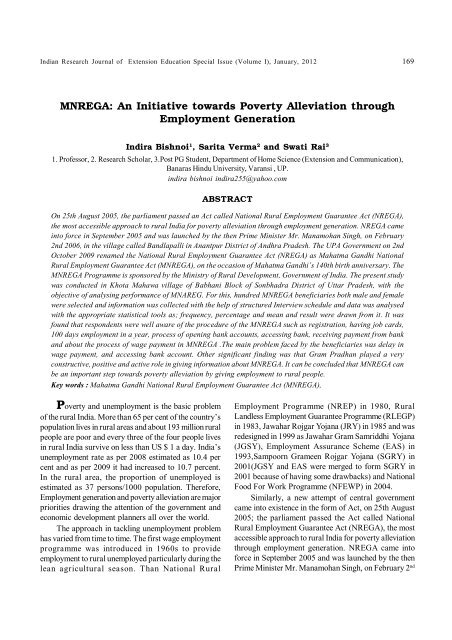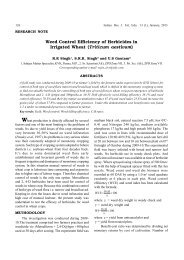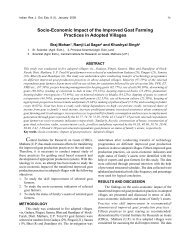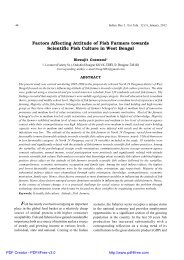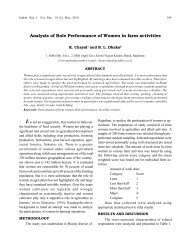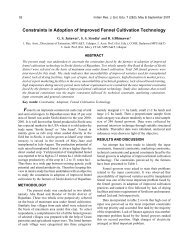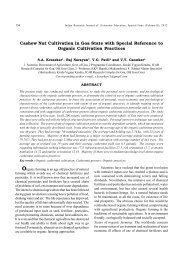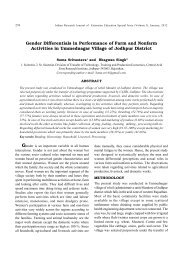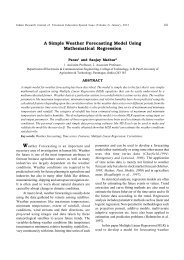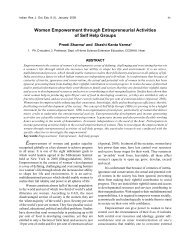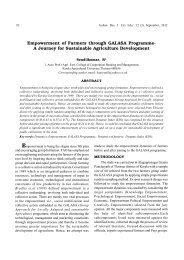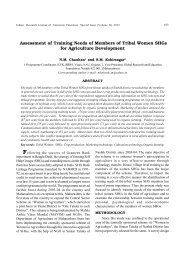MNREGA: An Initiative towards Poverty Alleviation ... - Seea.org.in
MNREGA: An Initiative towards Poverty Alleviation ... - Seea.org.in
MNREGA: An Initiative towards Poverty Alleviation ... - Seea.org.in
Create successful ePaper yourself
Turn your PDF publications into a flip-book with our unique Google optimized e-Paper software.
Indian Research Journal of Extension Education Special Issue (Volume I), January, 2012 169<br />
<strong>MNREGA</strong>: <strong>An</strong> <strong>Initiative</strong> <strong>towards</strong> <strong>Poverty</strong> <strong>Alleviation</strong> through<br />
Employment Generation<br />
Indira Bishnoi 1 , Sarita Verma 2 and Swati Rai 3<br />
1. Professor, 2. Research Scholar, 3.Post PG Student, Department of Home Science (Extension and Communication),<br />
Banaras H<strong>in</strong>du University, Varansi , UP.<br />
<strong>in</strong>dira bishnoi <strong>in</strong>dira255@yahoo.com<br />
ABSTRACT<br />
On 25th August 2005, the parliament passed an Act called National Rural Employment Guarantee Act (NREGA),<br />
the most accessible approach to rural India for poverty alleviation through employment generation. NREGA came<br />
<strong>in</strong>to force <strong>in</strong> September 2005 and was launched by the then Prime M<strong>in</strong>ister Mr. Manamohan S<strong>in</strong>gh, on February<br />
2nd 2006, <strong>in</strong> the village called Bandlapalli <strong>in</strong> <strong>An</strong>antpur District of <strong>An</strong>dhra Pradesh. The UPA Government on 2nd<br />
October 2009 renamed the National Rural Employment Guarantee Act (NREGA) as Mahatma Gandhi National<br />
Rural Employment Guarantee Act (<strong>MNREGA</strong>), on the occasion of Mahatma Gandhi’s 140th birth anniversary. The<br />
<strong>MNREGA</strong> Programme is sponsored by the M<strong>in</strong>istry of Rural Development, Government of India. The present study<br />
was conducted <strong>in</strong> Khota Mahawa village of Babhani Block of Sonbhadra District of Uttar Pradesh, with the<br />
objective of analys<strong>in</strong>g performance of MNAREG. For this, hundred <strong>MNREGA</strong> beneficiaries both male and female<br />
were selected and <strong>in</strong>formation was collected with the help of structured Interview schedule and data was analysed<br />
with the appropriate statistical tools as; frequency, percentage and mean and result were drawn from it. It was<br />
found that respondents were well aware of the procedure of the <strong>MNREGA</strong> such as registration, hav<strong>in</strong>g job cards,<br />
100 days employment <strong>in</strong> a year, process of open<strong>in</strong>g bank accounts, access<strong>in</strong>g bank, receiv<strong>in</strong>g payment from bank<br />
and about the process of wage payment <strong>in</strong> <strong>MNREGA</strong> .The ma<strong>in</strong> problem faced by the beneficiaries was delay <strong>in</strong><br />
wage payment, and access<strong>in</strong>g bank account. Other significant f<strong>in</strong>d<strong>in</strong>g was that Gram Pradhan played a very<br />
constructive, positive and active role <strong>in</strong> giv<strong>in</strong>g <strong>in</strong>formation about <strong>MNREGA</strong>. It can be concluded that <strong>MNREGA</strong> can<br />
be an important step <strong>towards</strong> poverty alleviation by giv<strong>in</strong>g employment to rural people.<br />
Key words : Mahatma Gandhi National Rural Employment Guarantee Act (<strong>MNREGA</strong>),<br />
<strong>Poverty</strong> and unemployment is the basic problem<br />
of the rural India. More than 65 per cent of the country’s<br />
population lives <strong>in</strong> rural areas and about 193 million rural<br />
people are poor and every three of the four people lives<br />
<strong>in</strong> rural India survive on less than US $ 1 a day. India’s<br />
unemployment rate as per 2008 estimated as 10.4 per<br />
cent and as per 2009 it had <strong>in</strong>creased to 10.7 percent.<br />
In the rural area, the proportion of unemployed is<br />
estimated as 37 persons/1000 population. Therefore,<br />
Employment generation and poverty alleviation are major<br />
priorities draw<strong>in</strong>g the attention of the government and<br />
economic development planners all over the world.<br />
The approach <strong>in</strong> tackl<strong>in</strong>g unemployment problem<br />
has varied from time to time. The first wage employment<br />
programme was <strong>in</strong>troduced <strong>in</strong> 1960s to provide<br />
employment to rural unemployed particularly dur<strong>in</strong>g the<br />
lean agricultural season. Than National Rural<br />
Employment Programme (NREP) <strong>in</strong> 1980, Rural<br />
Landless Employment Guarantee Programme (RLEGP)<br />
<strong>in</strong> 1983, Jawahar Rojgar Yojana (JRY) <strong>in</strong> 1985 and was<br />
redesigned <strong>in</strong> 1999 as Jawahar Gram Samriddhi Yojana<br />
(JGSY), Employment Assurance Scheme (EAS) <strong>in</strong><br />
1993,Sampoorn Grameen Rojgar Yojana (SGRY) <strong>in</strong><br />
2001(JGSY and EAS were merged to form SGRY <strong>in</strong><br />
2001 because of hav<strong>in</strong>g some drawbacks) and National<br />
Food For Work Programme (NFEWP) <strong>in</strong> 2004.<br />
Similarly, a new attempt of central government<br />
came <strong>in</strong>to existence <strong>in</strong> the form of Act, on 25th August<br />
2005; the parliament passed the Act called National<br />
Rural Employment Guarantee Act (NREGA), the most<br />
accessible approach to rural India for poverty alleviation<br />
through employment generation. NREGA came <strong>in</strong>to<br />
force <strong>in</strong> September 2005 and was launched by the then<br />
Prime M<strong>in</strong>ister Mr. Manamohan S<strong>in</strong>gh, on February 2 nd
170 Indian Research Journal of Extension Education Special Issue (Volume I), January, 2012<br />
2006, <strong>in</strong> the village called Bandlapalli <strong>in</strong> <strong>An</strong>antpur District<br />
of <strong>An</strong>dhra Pradesh. The UPA Government on 2nd<br />
October 2009 renamed National Rural Employment<br />
Guarantee Act (NREGA) as Mahatma Gandhi, on the<br />
occasion of Mahatma Gandhi’s 140th birth anniversary.<br />
This Programme is sponsored by the M<strong>in</strong>istry of Rural<br />
Development, Government of India. As <strong>MNREGA</strong> aims<br />
for employment at least 100 days <strong>in</strong> a year ,Therefore<br />
present study was undertaken with the follow<strong>in</strong>g<br />
objectives,<br />
1. To study the socio demographic <strong>in</strong>formation of the<br />
respondents.<br />
2. To study and analyze the performance of<br />
<strong>MNREGA</strong> <strong>in</strong> terms of-<br />
2.1 Awareness and Accessibility of <strong>MNREGA</strong><br />
2.2 Employment generation under <strong>MNREGA</strong><br />
2.3 Process of Wage payment <strong>in</strong> <strong>MNREGA</strong><br />
2.4 Extent of satisfaction of respondents about<br />
<strong>MNREGA</strong><br />
3. To study the bank accessibility of <strong>MNREGA</strong><br />
beneficiaries.<br />
4. To f<strong>in</strong>d out the constra<strong>in</strong>ts face by the <strong>MNREGA</strong><br />
beneficiaries <strong>in</strong> wage collection.<br />
METHODOLOGY<br />
The present study was conducted <strong>in</strong> Khota<br />
Mahawa village of Babhani Block <strong>in</strong> Sonbhadra District<br />
of Uttar Pradesh.This village was 5 km. away from<br />
Bhadani town.100 <strong>MNREGA</strong> beneficiaries both male<br />
and female were selected randomly irrespective of cash<br />
and f<strong>in</strong>ancial conditions. Data was collected with the<br />
help of pre-tested structured Interview Schedule. Period<br />
of data collection was from January 2011 to March<br />
2011, data was collected dur<strong>in</strong>g February 2011 To March<br />
2011, collected data was tabulation was analysed by<br />
us<strong>in</strong>g frequency, percentage and mean.<br />
RESULT AND DISCUSSION<br />
Majority of the respondents (44 per cent) were of<br />
26-35 years of age group, followed by 26 per cent <strong>in</strong><br />
the age group of 36-45 years and rest were above 45<br />
years. 54 per cent respondents were male while 46<br />
percent female. It shows that rules were followed <strong>in</strong><br />
giv<strong>in</strong>g work to female. All the respondents were married<br />
and 44 percent belonged to jo<strong>in</strong>t family and rest belonged<br />
to nuclear family. 44 per cent respondents belonged to<br />
large size family hav<strong>in</strong>g more than 10 members .20 per<br />
cent of the respondents belonged to schedule caste and<br />
80 per cent to Schedule Tribes, 86 per cent of the<br />
respondents were illiterate and 12 per cent respondents<br />
had primary education. 58 per cent respondents were<br />
BPL card holders, 12 per cent respondents were APL<br />
card holders and rest 30 per cent had <strong>An</strong>toaya Cards.<br />
All the respondents had kaccha house. Majority of the<br />
respondents (68 per cent) had their monthly <strong>in</strong>come<br />
Rs.1000-1500, 26 per cent had monthly <strong>in</strong>come<br />
Upto Rs.1000 rest had monthly <strong>in</strong>come of Rs. 2000 per<br />
month.<br />
All the result proves that all the beneficiaries were<br />
from very poor f<strong>in</strong>ancial background as none of the<br />
respondents had even half kaccha and half pacca house.<br />
For them work<strong>in</strong>g <strong>in</strong> <strong>MNREGA</strong> was really worth<br />
work<strong>in</strong>g.<br />
Table 1. Socio-demographic profile of the respondents<br />
(N=100)<br />
Characteristics Categories No. (%)<br />
Age 18-25 years 04<br />
26-35 years 44<br />
36-45 years 26<br />
Above 45 26<br />
Sex Male 54<br />
Female 46<br />
Marital status Married 100<br />
Family type Nuclear 56<br />
Jo<strong>in</strong>t 44<br />
Family size Small (upto 5 members) 28<br />
Medium (6-12 members) 28<br />
Large (>10 members) 44<br />
Religion H<strong>in</strong>du 100<br />
Caste Schedule Caste 20<br />
Schedule Tribes 80<br />
Education Illiterate 86<br />
Primary 12<br />
High school 02<br />
Land Hold<strong>in</strong>g Landless 18<br />
Upto 2 Bissa 48<br />
2-4 Bissa 34<br />
Card Hold<strong>in</strong>g B.P.L. Card 58<br />
A.P.L. 12<br />
<strong>An</strong>todaya Card 30<br />
House Type Kachha house 100<br />
Monthly Income Upto 1000 26<br />
Rs.1000-1500 68<br />
Rs.1501-2000 6
Indian Research Journal of Extension Education Special Issue (Volume I), January, 2012 171<br />
To study and analyze the performance of <strong>MNREGA</strong><br />
<strong>in</strong> terms of-<br />
2.1. Awareness and accessibility of <strong>MNREGA</strong><br />
Table No. 2.1.a, Distribution of respondents accord<strong>in</strong>g to<br />
the sources of Information about <strong>MNREGA</strong><br />
Sources of <strong>in</strong>formation about <strong>MNREGA</strong><br />
No. (N=100)<br />
Gram Panchayat/Gram Pradhan 100<br />
B.D.O. 00<br />
Panchayat Sachiv 00<br />
T.V./Radio 00<br />
Total 100<br />
Table No. 2.1.a, reveals that Gram Panchayat/<br />
Gram Pradhan was the only source, who had given<br />
<strong>in</strong>formation about <strong>MNREGA</strong> to all the villagers, while<br />
other sources could not contribute any <strong>in</strong>formation <strong>in</strong><br />
any form to beneficiaries.<br />
Table No.2.1.b. Distribution of respondents accord<strong>in</strong>g to<br />
their Knowledge about Registration for <strong>MNREGA</strong><br />
Knowledge about Registration<br />
No. (N=100)<br />
Had Knowledge 87<br />
Had No Knowledge 13<br />
Total 100<br />
Table No.2.1.b. reveals that majority of the<br />
respondents (87 per cent) had knowledge about<br />
registration which is requirement for gett<strong>in</strong>g work under<br />
this scheme, while rest had no knowledge about<br />
registration.<br />
Table No. 2.1.c. Distribution of respondents accord<strong>in</strong>g to<br />
the time period s<strong>in</strong>ce respondents were benefited by<br />
<strong>MNREGA</strong><br />
Time period s<strong>in</strong>ce respondents<br />
were benefited<br />
No. (N=100)<br />
6 Months 10<br />
1 Year 21<br />
2 Years 32<br />
3 Years 37<br />
Total 100<br />
Table No. 3.1.c reveals that majority of the<br />
respondents (37 per cent) were benefited by <strong>MNREGA</strong><br />
for the last 3 years and 32 per cent of the respondents<br />
were benefited by <strong>MNREGA</strong> from 2 years and rest 10<br />
and 21 per cent were benefited from six months and<br />
one year respectively.<br />
2.2. Employment generation under <strong>MNREGA</strong><br />
Table No.2.2.a. Distribution of the respondents accord<strong>in</strong>g<br />
to the process adopted by them for registration <strong>in</strong><br />
<strong>MNREGA</strong><br />
Process adopted by respondents for<br />
registration <strong>in</strong> <strong>MNREGA</strong><br />
No. (N=100)<br />
Written 14<br />
Oral 86<br />
Total 100<br />
Table No.3.2.b. Reveals that majority of the<br />
respondents( 86 per cent) reported that oral process<br />
was adopted by them for the registration <strong>in</strong> <strong>MNREGA</strong><br />
and rest 14 per cent respondents had adopted oral<br />
process for registration .<br />
Table No.2.2.b. Distribution of the respondents<br />
accord<strong>in</strong>g to issue of job cards<br />
Issue job cards to<br />
No. (N=100)<br />
Individual 26<br />
Households 74<br />
Total 100<br />
Table No.3.2.b. reveals that 26 per cent of the<br />
respondents were issued <strong>in</strong>dividual job cards and 74 per<br />
cent of the respondents were issued household job card.<br />
Table No.2.2.c Distribution of the respondents accord<strong>in</strong>g<br />
to their responses on 100 days of employment<br />
guaranteed under <strong>MNREGA</strong><br />
<strong>MNREGA</strong> provide 100 days’ work<br />
No. (N=100)<br />
It provides 100 days work 92<br />
It did not provide 100 days work 08<br />
Total 100<br />
Table No.2.2, c. Majority of the respondents (92<br />
per cent) reported that they were gett<strong>in</strong>g 100 days of<br />
employment under <strong>MNREGA</strong> and rest 8 per cent<br />
reported that they were not gett<strong>in</strong>g 100 days of<br />
employment.<br />
Table No.2.2.d. Distribution of the respondents accord<strong>in</strong>g<br />
to the k<strong>in</strong>ds of work assigned to female beneficiaries<br />
of <strong>MNREGA</strong><br />
K<strong>in</strong>d of work assigned to female beneficiaries<br />
No. (N=100)<br />
Less labourious work -<br />
Assist<strong>in</strong>g male workers -<br />
Carriage of soil, sand and bricks -<br />
Above all 100<br />
Total 100
172 Indian Research Journal of Extension Education Special Issue (Volume I), January, 2012<br />
Table No.2.2.d. Reveals that all the respondents<br />
were agreed that all the above k<strong>in</strong>ds of work assigned<br />
to female beneficiaries of <strong>MNREGA</strong>.<br />
Table No.2.2.e. Distribution of the respondents accord<strong>in</strong>g<br />
to provision of work with<strong>in</strong> 5 km.<br />
Provision of work with<strong>in</strong> 5 km.<br />
No. (N=100)<br />
Work provided with<strong>in</strong> 5 km. 100<br />
Not provided with<strong>in</strong> 5 km. 00<br />
Total 100<br />
Table No.3.2.e All the 100 per cent of the<br />
respondents were aware of the provision of work with<strong>in</strong><br />
5 km.<br />
3. Process of Wage payment <strong>in</strong> <strong>MNREGA</strong><br />
Table No.2.2.a. Distribution of the respondents accord<strong>in</strong>g<br />
to Payment received with<strong>in</strong> 15 Days.<br />
Payment received with<strong>in</strong>15 Days<br />
No. (N=100)<br />
Received 92<br />
Not Received 18<br />
Total 100<br />
Table No.2.2.a. 92 per cent of the respondents<br />
reported that payment were received with<strong>in</strong>15 Days<br />
and rest did not receive their payment with<strong>in</strong>15 Days.<br />
Table No.2.2.b. Distribution of the respondents accord<strong>in</strong>g<br />
to the average amount paid <strong>in</strong> <strong>MNREGA</strong><br />
Amount of wage paid<br />
No. (N=100)<br />
< Rs.100 per day -<br />
Rs.100 per day 100<br />
>Rs. 100 per day -<br />
Total 100<br />
Table No.2.2.b All the 100 per cent of the<br />
respondents were paid Rs.100 per day <strong>in</strong> <strong>MNREGA</strong>.<br />
2.4. Extent of satisfaction of respondents about<br />
<strong>MNREGA</strong>-<br />
Table No.2.4. Distribution of the respondents on their level<br />
of satisfaction about <strong>MNREGA</strong><br />
Extent of satisfaction<br />
No. (N=100)<br />
Less satisfied 10<br />
Satisfied 15<br />
Fully satisfied 75<br />
Total 100<br />
Table No.2.4 Reveal that the majority of the<br />
respondents (75 Per cent) were fully satisfied and 15<br />
per cent were satisfied rest were less satisfied with<br />
<strong>MNREGA</strong>.<br />
3. Bank accessibility of <strong>MNREGA</strong> beneficiaries<br />
3.1 Process of open<strong>in</strong>g account<br />
Table No.3.1.a Distribution of the respondents possess<strong>in</strong>g<br />
bank accounts<br />
Bank Accounts<br />
No. (N=100)<br />
Had no bank accounts 00<br />
Had bank accounts 100<br />
Total 100<br />
Table No.3.1.a reveals that all the respondents had<br />
bank accounts.<br />
Table No.3.1.b. Distribution of the respondents on the<br />
basis of type of bank account<br />
Type of Bank Accounts<br />
No. (N=100)<br />
Individual Account 26<br />
Jo<strong>in</strong>t Account 74<br />
Total 100<br />
Table No.3.1.b. Reveals that majority of the<br />
respondents (74 per cent) had jo<strong>in</strong>t account and 26 per<br />
cent of the respondents had <strong>in</strong>dividual account.<br />
Table No.3.1.c. Distribution of the respondents on the<br />
basis of amount paid for open<strong>in</strong>g a bank account<br />
Amount paid for open<strong>in</strong>g Bank Accounts<br />
No. (N=100)<br />
Rs.100 46<br />
Rs.150 56<br />
Total 100<br />
Table No.3.1.c. reveals that majority of the<br />
respondents (56 per cent ) had opened their account<br />
with Rs.150 and 46 percent had opened their account<br />
with Rs. 100.<br />
3.2. Process of receiv<strong>in</strong>g payment<br />
Table No.3.2.a Distribution of the respondents accord<strong>in</strong>g<br />
to modes of payment <strong>in</strong> <strong>MNREGA</strong><br />
Payment received In<br />
No. (N=100)<br />
Cash -<br />
Bank Accounts 100<br />
Total 100<br />
Table No.3.2.a Reveals that all the respondents<br />
had received their payment <strong>in</strong> their bank accounts.<br />
Table No.3.2.b. Distribution of the respondents accord<strong>in</strong>g<br />
to collection of their wages from the bank<br />
Collect<strong>in</strong>g wages from the bank through<br />
No. (N=100)<br />
Self 14<br />
Gram Rojgar Sewak 86<br />
Total 100
Indian Research Journal of Extension Education Special Issue (Volume I), January, 2012 173<br />
Table No.3.2.b. Reveals that majority of the<br />
respondents (86 per cent) were collect<strong>in</strong>g their wages<br />
from the bank through Gram Rojgar Sewak while 14<br />
per cent were collect<strong>in</strong>g their wages from the bank<br />
themselves.<br />
5.Constra<strong>in</strong>ts faced by the <strong>MNREGA</strong> Beneficiaries<br />
<strong>in</strong> wage collection<br />
TableNo.5 Distribution of the respondents on the basis of<br />
k<strong>in</strong>d of problems faced by them <strong>in</strong> collect<strong>in</strong>g their wages<br />
Types of constra<strong>in</strong>ts faced <strong>in</strong><br />
No. (N=100)<br />
Collect<strong>in</strong>g wages<br />
Problem <strong>in</strong> access<strong>in</strong>g bank 23<br />
It takes Long time 12<br />
Delays <strong>in</strong> wage payment 44<br />
Asked to come another day 21<br />
Total 100<br />
Table No.5 Reveals that majority of the<br />
respondents(44 per cent) reported that they faced the<br />
problem of delay <strong>in</strong> wage payment ,23 per cent<br />
respondents had problem <strong>in</strong> access<strong>in</strong>g bank and 21 per<br />
cent reported that they were asked to come another<br />
day for wage payment and rest were reported that wage<br />
payment process took long time.<br />
CONCLUSION<br />
It can be concluded from the present study that<br />
respondents were well aware of the procedure of the<br />
<strong>MNREGA</strong> such as registration, hav<strong>in</strong>g job cards, 100<br />
days employment <strong>in</strong> a year, Process of open<strong>in</strong>g bank<br />
accounts, access<strong>in</strong>g bank, receiv<strong>in</strong>g payment from bank<br />
and about the process of wage payment <strong>in</strong> <strong>MNREGA</strong>.<br />
They were aware of employment generation process.<br />
they faced the problem of delay <strong>in</strong> wage payment,<br />
problem <strong>in</strong> access<strong>in</strong>g bank and were asked to come<br />
another day for wage payment Further, it also reveals<br />
that there was monitor<strong>in</strong>g of work at all levels from<br />
Gram Pradhan to Block Officers .Other important po<strong>in</strong>ts<br />
which had emerged that Gram Pradhan played a very<br />
constructive, positive and active role <strong>in</strong> giv<strong>in</strong>g <strong>in</strong>formation<br />
about <strong>MNREGA</strong>. So it can be concluded that <strong>MNREGA</strong><br />
can be an important step <strong>in</strong> poverty alleviation through<br />
employment generation <strong>in</strong> rural population.<br />
REFERENCES<br />
Kurukshetra : A Journal of Rural Development. March 2011.P.P.41-42. Kurukshetra : A Journal of Rural Development. December<br />
2009.P.P.2-41.<br />
Nrega.nic.<strong>in</strong>/presentation/implement-NREGA.ppt.<br />
http://narega.nic.<strong>in</strong>/NREGA_guidel<strong>in</strong>esEng.pdf<br />
http://www.cs-delhi.com/events/downloads/nrega-concept_note.pdf<br />
http://EXTENSION OF NREGA ACROSS THE COUNTRY


